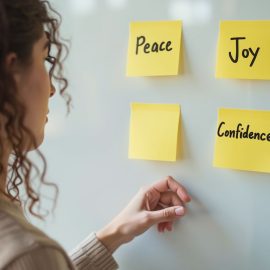

This article is an excerpt from the Shortform book guide to "Untamed" by Glennon Doyle. Shortform has the world's best summaries and analyses of books you should be reading.
Like this article? Sign up for a free trial here .
Why is it so important to always trust your instincts? What happens if you don’t listen to your instincts?
The tendency to look to others for validation has diminished your ability to tap into your intuition and trust your decisions. Author Glennon Doyle explains how you can learn to always trust your instincts through quiet reflection.
Read on to find out why trusting your gut feeling is crucial for happiness and learn to recover your capacity for believing your instincts.
Embracing Intuition
We have learned how embracing emotion and not fearing pain can free you from the limitations of your social conditioning. Now, we’ll explore Doyle’s second pathway towards freedom: embracing your intuition.
Always trusting your instincts involves being guided by a deep sense of inner truth. When you deeply understand yourself, you can make confident decisions. In this section, we will learn about Doyle’s experiences doubting her intuition, what happened when she finally embraced it, and how she developed a method for tapping into her inner knowledge. We will then explore how you can trust your gut feeling in your everyday life.
Doubting Your Intuition
Doyle observes that women are conditioned to please and seek approval from others—as a result, they don’t always trust their instincts and search externally for advice and validation. Doyle realized this during a crisis in her marriage.
After she became pregnant with her first child, Doyle married the father of her baby, Craig Melton. Several years into their marriage, Craig admitted to having multiple affairs with other women. Doyle had to decide if she wanted to stay in the marriage, and she looked to outside sources for advice. She asked friends, read books, and even consulted Google, but no one could answer her question.
Doyle realized no one else shared her life experiences, and therefore she had to make this decision by herself. She had to find a way to connect with herself deeply to make decisions based on her inner wisdom and intuition rather than others’ opinions.
| The Damage of Low Self-Confidence in the Workplace Doyle discusses women’s lack of confidence in the context of their personal lives, but this issue extends much further—many women also experience the negative effects of low self-confidence in the workplace. In The Confidence Code, authors Katty Kay and Claire Shipman point out how a woman’s lack of confidence at work and the deferential behaviors they display can result in lower pay, fewer opportunities for advancement, and feelings of inadequacy. Their inclination to distrust their instincts and look to others for validation inhibits their ability to take the sort of confident action that would earn respect and rewards in the workplace. They suggest that women increase their confidence in the workplace by focusing less on deferential behaviors, such as perfectionism and people-pleasing, and more on action and risk-taking. They advocate the “fail fast” approach: taking action on several of your own ideas, expecting some of them to fail. Getting used to taking action—and learning not to fear failure—makes women self-reliant and less deferential. |
Always Trust Your Instincts to Deeply Connect With Your True Self
When it comes to always trusting your instincts, Doyle realized that she had to make decisions about her marriage that were aligned with her deepest self, but she didn’t know how to access this self. Then she received a card from a friend that encouraged her to become quiet and listen to her inner knowledge. After receiving this message, Doyle felt inspired to take time for reflection in a quiet space.
As she sat in stillness, Doyle developed a way of accessing her intuition: She “sank into” a different version of herself. This deeper version of herself existed on a different level from the self she presented to the world; it was wise, grounded, and full of insight. She felt more focused and aware of her deepest convictions when accessing this deeper self.
She also experienced a deep connection with the spiritual core of her being, where she felt a sense of certainty flowing inside of her and a sense of connection to a divine presence.
When she posed a question to this different version of herself, she felt a gentle push toward the right decision and believed that this was her intuition guiding her.
| Different Perspectives on Intuitive Decision Making Many agree with Doyle in her claim that relying on your intuition is a great way to make healthy, empowered decisions. In The Gifts of Imperfection, Brené Brown encourages intuitive decision-making and adds that sometimes your intuition goes beyond telling you the right thing to do to tell you when you don’t have enough information to make a decision. On the other hand, some authors advocate approaches to decision-making that don’t depend on always trusting your instincts—suggesting that incorporating more concrete practices can improve your intuitive sense. For example, in Blink, Malcolm Gladwell suggests that you take time to use deliberate thinking in combination with intuitive thinking. Deliberate thinking involves gathering facts and acknowledging what you don’t know before making a decision. Carefully thinking through a problem in this way can help you avoid blind spots and biases—laying the groundwork for quick and accurate intuitive decision-making when the time is right. |
Should You Always Trust Your Instincts in Daily Life?
The practice of tapping into her intuition empowered Doyle to make decisions that aligned with her inner self. She no longer felt she had to consult others for advice or validation. Her intuition freed her from being controlled by society’s expectations and empowered her to make her own choices.
When making a difficult decision, you can use Doyle’s method for tapping into your intuition:
- Retreat to a quiet place where all you hear is your breath.
- Sink into your consciousness and become aware of a deeper sense of yourself.
- Connect and commune with this version of yourself.
- Ask a question in this mental space and see if you sense a gentle push towards the next step to take.
- Sit and reflect on this new knowledge and insight.
Always trusting your instincts will get you in touch with your intuition, allowing you to make your own choices, confident that your decisions come from a place of strength and inner knowledge. (Shortform note: Doyle’s practice of self-reflection relies on individual empowerment, but this may not be the best approach for everyone. Like many people, you may want to feel supported by a community as you seek truth and pursue wisdom. There are many ways you can find this community support—for example, you can get involved with a faith community, join a meditation group, or talk with a therapist or spiritual counselor.)
| Practical Steps for Successfully Accessing Your Intuition It’s important to note that there are a variety of practices that can be useful in accessing your intuition—if Doyle’s process of connecting to a deeper sense of self feels a bit too ambiguous for you to replicate, you might try incorporating more concrete steps into your practice. In The Success Principles, Jack Canfield shares his approach to accessing intuition—an approach that is similar to Doyle’s practice in some ways, but includes some more relatable practices. Canfield’s first recommendation is that you prepare your mind and body for meditation by sitting comfortably and practicing relaxation techniques such as deep breathing. Canfield then recommends that you find a focal point (such as a lighted candle) and repeat a single word or phrase, such as “relax” or “I am love.” Repetition can clear your mind and help you focus. Beyond asking you to sit in a quiet, dark space, Doyle doesn’t emphasize meditation preparation practices as much as Canfield does. However, you might find that combining her suggestions with Canfield’s practical advice more effectively gets you into the deep, reflective headspace required for “sinking into” your inner self as Doyle does. Canfield’s next step is to shift into a mode in which you are more receptive to messages and intuition. For Doyle, this receptive mode is a headspace in which she receives messages as a gentle nudge from her inner voice. You may initially find it difficult to get in touch with this nebulous “inner voice”—fortunately, Canfield points out, there are many ways that you can receive messages from your intuition. He suggests focusing on something more tangible: the emotions and physical sensations you feel as you meditate. You can think of these sensations as surface-level messages from your intuition. For example, you pose a question during a meditation session and feel anxiety and tension throughout your body. Your intuition could be telling you that that decision is not the way to go. Canfield’s practice includes a final step that Doyle doesn’t explore: Make an effort to come out of a state of meditation slowly. This gives you time to visualize how you might apply the wisdom you have gained. On the other hand, Doyle’s approach is more oriented towards an immediate return to your everyday activities, confident in your newfound wisdom. |

———End of Preview———
Like what you just read? Read the rest of the world's best book summary and analysis of Glennon Doyle's "Untamed" at Shortform .
Here's what you'll find in our full Untamed summary :
- Glennon Doyle's story of freeing herself from society's rules and expectations
- Why you should rebuild your life using emotion, intuition, and imagination
- A look at how young women are taught to repress their emotions and desires






